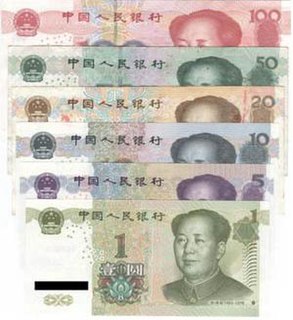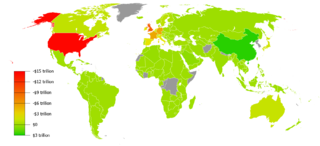Nominal exchange rates
List of nominal exchange rates

| Official historical average exchange rates of Renminbi for major foreign currencies by year [8] (Chinese yuan per 100 foreign currency units) | |||||
| Year | USD | JPY | HKD | Euro | |
| 2018 | 661.74 | 5.9890 | 84.428 | 780.16 | |
| 2017 | 675.18 | 6.0244 | 86.643 | 763.03 | |
| 2016 | 664.23 | 6.1243 | 85.578 | 734.26 | |
| 2015 | 622.84 | 5.1543 | 80.34 | 691.41 | |
| 2014 | 614.28 | 5.8196 | 79.220 | 816.51 | |
| 2013 | 619.32 | 6.3323 | 79.845 | 822.19 | |
| 2012 | 631.25 | 7.9037 | 81.376 | 810.67 | |
| 2011 | 645.88 | 8.1050 | 82.968 | 900.11 | |
| 2010 | 676.95 | 7.7279 | 87.130 | 897.25 | |
| 2009 | 683.10 | 7.2986 | 88.123 | 952.70 | |
| 2008 | 694.51 | 6.7427 | 89.190 | 1,022.27 | |
| 2007 | 760.40 | 6.4632 | 97.459 | 1,041.75 | |
| 2006 | 797.18 | 6.8570 | 102.620 | 1,001.90 | |
| 2005 | 819.17 | 7.4484 | 105.300 | 1,019.53 | |
| 2004 | 827.68 | 7.6552 | 106.230 | 1,029.00 | |
| 2003 | 827.70 | 7.1466 | 106.240 | 936.13 | |
| 2002 | 827.70 | 6.6237 | 106.070 | 800.58 | |
| 2001 | 827.70 | 6.8075 | 106.080 | ||
| 2000 | 827.84 | 7.6864 | 106.180 | ||
| 1999 | 827.83 | 7.2932 | 106.660 | ||
| 1998 | 827.91 | 6.3488 | 106.880 | ||
| 1997 | 828.98 | 6.8600 | 107.090 | ||
| 1996 | 831.42 | 7.6352 | 107.510 | ||
| 1995 | 835.10 | 8.9225 | 107.960 | ||
| 1994 | 861.87 | 8.4370 | 111.530 | ||
| 1993 | 576.20 | 5.2020 | 74.410 | ||
| 1992 | 551.46 | 4.3608 | 71.240 | ||
| 1991 | 532.33 | 3.9602 | 68.450 | ||
| 1990 | 478.32 | 3.3233 | 61.390 | ||
| 1989 | 376.51 | 2.7360 | 48.280 | ||
| 1988 | 372.21 | 2.9082 | 47.700 | ||
| 1987 | 372.21 | 2.5799 | 47.740 | ||
| 1986 | 345.28 | 2.0694 | 44.220 | ||
| 1985 | 293.66 | 1.2457 | 37.570 | ||
| 1984 | 232.70 | 0.9780 | 29.710 | ||
| 1983 | 197.57 | 0.8318 | 27.360 | ||
| 1982 | 189.25 | 0.7607 | 31.150 | ||
| 1981 | 170.50 | 0.7735 | 30.410 | ||
List of World Bank nominal exchange rates
| World Bank annual average middle exchange rate for US dollar to Chinese yuan [9] ( 1 US dollar to Chinese yuan ) | |||||||
| Year | US dollar | Year | US dollar | Year | US dollar | Year | US dollar |
| 2019 | 2004 | 8.2768 | 1989 | 4.9400 | 1974 | 1.9612 | |
| 2018 | 6.98 | 2003 | 8.2770 | 1988 | 4.8600 | 1973 | 1.9894 |
| 2017 | 6.89 | 2002 | 8.2770 | 1987 | 4.4600 | 1972 | 2.2451 |
| 2016 | 2001 | 8.2771 | 1986 | 3.4500 | 1971 | 2.4618 | |
| 2015 | 2000 | 8.2784 | 1985 | 2.9400 | 1970 | 2.4618 | |
| 2014 | 1999 | 8.2783 | 1984 | 2.8000 | 1969 | 2.4618 | |
| 2013 | 1998 | 8.2791 | 1983 | 2.6100 | 1968 | 2.4618 | |
| 2012 | 6.3123 | 1997 | 8.2898 | 1982 | 2.6200 | 1967 | 2.4618 |
| 2011 | 6.4615 | 1996 | 8.3142 | 1981 | 2.5200 | 1966 | 2.4618 |
| 2010 | 6.7703 | 1995 | 8.3507 | 1980 | 2.4000 | 1965 | 2.4618 |
| 2009 | 6.8300 | 1994 | 8.6187 | 1979 | 2.3000 | 1964 | 2.4618 |
| 2008 | 6.9451 | 1993 | 8.0213 | 1978 | 2.4600 | 1963 | 2.4618 |
| 2007 | 7.6075 | 1992 | 6.3700 | 1977 | 1.8578 | 1962 | 2.4618 |
| 2006 | 7.9734 | 1991 | 5.7400 | 1976 | 1.9414 | 1961 | 2.4618 |
| 2005 | 8.1943 | 1990 | 5.2300 | 1975 | 1.8598 | 1960 | 2.4618 |
List of IMF nominal exchange rates
| International Monetary Fund annual average middle exchange rate for US dollar to Chinese yuan [10] ( 1 US dollar to Chinese yuan ) | |||||||
| Year | US dollar | Year | US dollar | Year | US dollar | Year | US dollar |
| 2019 | 2009 | 6.8310 | 1999 | 8.2783 | 1989 | 3.7651 | |
| 2018 | 2008 | 6.9480 | 1998 | 8.2790 | 1988 | 3.7221 | |
| 2017 | 2007 | 7.6071 | 1997 | 8.2898 | 1987 | 3.7221 | |
| 2016 | 2006 | 7.9735 | 1996 | 8.3142 | 1986 | 3.4528 | |
| 2015 | 2005 | 8.1942 | 1995 | 8.3514 | 1985 | 2.9367 | |
| 2014 | 2004 | 8.2768 | 1994 | 8.6187 | 1984 | 2.3200 | |
| 2013 | 6.15 | 2003 | 8.2770 | 1993 | 5.7620 | 1983 | 1.9757 |
| 2012 | 6.3124 | 2002 | 8.2769 | 1992 | 5.5146 | 1982 | 1.8925 |
| 2011 | 6.4614 | 2001 | 8.2771 | 1991 | 5.3234 | 1981 | 1.7045 |
| 2010 | 6.7704 | 2000 | 8.2784 | 1990 | 4.7832 | 1980 | 1.4984 |





